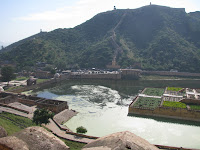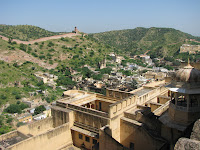We start the day in the city of Amber, just outside of Jaipur's city walls. Amber was the first capitol city for this area's kingdom. I enter the Amber Palace on the back of an elephant. This would have been more fun if I had not had an elephant with allergies. I ended my ride covered in elephant snot.
After passing, via elephant, through the main gate you arrive in a large courtyard. From this courtyard you pass through another gate into the Palace. This gate is decorated in elegant frescoes.
The gate leads you to the public area of the Palace featuring the Diwan-i-aam or public meeting hall.
To enter the private areas of the Palace you must go through the impressive Ganesha Pol, aka Ganesha Gate.
The private areas are comprised of winter and summer apartments. These areas use innovative ways to manage the extreme temperatures. The walls of the apartments are 20 inches thick and hollow to provide insulation from the elements. The winter apartment is on a lower level to protect it from wind and covered in small mirror inlays to reflect the heat provided by candles and oil lamps.
The summer apartments are on the upper level to take advantage of the wind. The domes serve as water tanks. In the summer grass curtains were hung along the edges of the apartment. Water from the tanks was then dripped on to the curtains through holes in copper pipes. As the wind blew the curtains the water evaporated and cooled the air. Old fashioned A/C.
The upper levels also offer some great views of Jaipur and surrounding areas.
The Palace also has some impressive gardens.
This garden on the lake was designed so that when the lake was full the garden would appear to float like a carpet on the water.
Even the doors of the Amber Palace are intricately designed.
This door is sandalwood with an inlay of ivory and semi-precious stones.
This door is carved teakwood.
On the way put of the Palace I see a snake charmer. The snakes are defanged for safety but are still pretty impressive.
Our next stop is the Amber Fort, just up the hill.
The fort served as the military base for the kingdom. A series of passageways connects it to the Palace below. The best part of the fort complex is the views:
And Jaivana, a 20 foot long cannon forged in 1720. It was fired only once and is reported to have launched its projectile more the 20 miles. It is beautiful, for a cannon.
After the Fort, we visit the cremation site of many of the local royals. These monuments, called chandri, are unusual. Ordinarily Hindus do not build monuments or mark the grave sites of their dead, instead the dead are cremated and some of the ashes committed to a river, preferably the Ganges. There are no remains here only elaborately carved marble.
After a brief rest at the hotel we venture out to Galwar Bagh, the monkey temple. The temple complex sits at the bottom of a granite canyon just outside of Jaipur. The temple is built on the place where a holy man named, Gulta Ji, reportedly brought forth a spring from the holy Ganges. The spring feeds the 3 pools on the site used for ritual bathes. The temple is not dedicated to the monkey god, Hanuman, rather it is called monkey temple due to the large number of monkeys that inhabit the site. GREAT, more monkeys!!!!
Today I am in luck, the temple is deserted (I am the only tourist) and there are very few monkeys.
The temple complex is old and worn. It is not taken care of as well as many of the other temple complexes I have seen but it is still amazing.
I meet with a monk at the temple who tells me the history of the temple and offers me a blessing (and takes my photo). I sit on the ground on a filthy pillow surrounded by wild red-faced monkeys and pray to the Hindu gods. The monk tells me I can pray to the Gods for anything and I find myself praying I won't be attacked by a monkey while I am sitting there with my eyes closed praying to Brahma, Vishnu, Shiva and Parvati.
Actually, the monkeys here are fairly well behaved and almost cute (note, I said almost) as they romp and play about the temple grounds.
It has been a long day of touring, trekking and avoiding monkeys and so I head back to the hotel to rest and recover for the next day's tour. Tomorrow, City Palace, the Observatory and the new city.
.JPG)


.JPG)


















.JPG)





.JPG)
.JPG)
.JPG)













.JPG)

.JPG)


.JPG)
.JPG)
.JPG)
.JPG)













